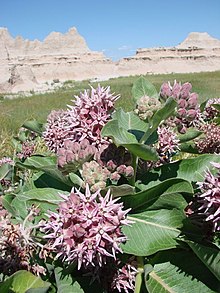Asclepias speciosa
| Asclepias speciosa | |
|---|---|

| |
| Scientific classification | |
| Kingdom: | Plantae |
| Clade: | Tracheophytes |
| Clade: | Angiosperms |
| Clade: | Eudicots |
| Clade: | Asterids |
| Order: | Gentianales |
| Family: | Apocynaceae |
| Genus: | Asclepias |
| Species: | A. speciosa
|
| Binomial name | |
| Asclepias speciosa | |

Asclepias speciosa is a milky-sapped perennial plant in the dogbane family (Apocynaceae), known commonly as the showy milkweed,[1] and is found in the Western half of North America.
Habitat and range
This species is native to the western half of North America.
Growth pattern
This flowering plant is a hairy, erect perennial.
Leaves and stems
The large, pointed, elongate, simple, entire leaves are arranged oppositely on stalks.
Inflorescence and fruit
The eye-catching, hirsute, pale pink through pinkish-purple flowers occur in dense umbellate cymes. Their corollas are reflexed and the central flower parts, five hoods with prominent hooks, form a star shape. The fruit is a large, rough follicle filled with many flat oval seeds, each with silky hairs.
This species flowers from May through September.[1]
Uses
Native Americans used fiber in the stems for rope, basketry, and nets.[1] Some Native Americans believed the milky sap had medicinal qualities, however, most species of milkweed are toxic,[1] particularly to livestock.[2]
The young leaves and seed pods can be boiled and eaten.[3]
Butterflies and moths
Asclepias speciosa is a specific monarch butterfly food and habitat plant. Additionally, phenylacetaldehyde produced by the plants attracts Synanthedon myopaeformis, the red-belted clearwing moth.[4] It is also a larval host for the dogbane tiger moth and the queen butterfly.[5]
References
- ^ a b c d Sierra Nevada Wildflowers, Karen Wiese, 2nd Ed. 2013, p. 60.
- ^ Fagan, Damian (2019). Wildflowers of Oregon: A Field Guide to Over 400 Wildflowers, Trees, and Shrubs of the Coast, Cascades, and High Desert. Guilford, CT: FalconGuides. p. 187. ISBN 1-4930-3633-5. OCLC 1073035766.
- ^ Lyons, C. P. (1956). Trees, Shrubs and Flowers to Know in Washington (1st ed.). Canada: J. M. Dent & Sons. p. 196.
- ^ Eby, Chelsea; Gardiner, Mark G.T.; Gries, Regine; Judd, Gary J.R.; Khaskin, Grigori; Gries, Gerhard (2013-04-01). "Phenylacetaldehyde attracts male and female apple clearwing moths, Synanthedon myopaeformis, to inflorescences of showy milkweed, Asclepias speciosa". Entomologia Experimentalis et Applicata. 147 (1): 82–92. doi:10.1111/eea.12045. ISSN 1570-7458. S2CID 84552298.
- ^ The Xerces Society (2016), Gardening for Butterflies: How You Can Attract and Protect Beautiful, Beneficial Insects, Timber Press.
External links
- Asclepias
- Butterfly food plants
- Flora of North America
- Natural history of the California chaparral and woodlands
- Natural history of the California Coast Ranges
- Natural history of the Central Valley (California)
- Natural history of the Mojave Desert
- Natural history of the Peninsular Ranges
- Natural history of the Transverse Ranges
- Plants used in traditional Native American medicine
